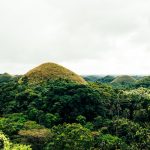Download links
How to install Exploring the Enigmatic Chocolate Hills of fb777 APK?
1. Tap the downloaded Exploring the Enigmatic Chocolate Hills of fb777 APK file.
2. Touch install.
3. Follow the steps on the screen.
Description
The Chocolate Hills, a geological wonder located in the Bohol province of the Philippines, have long captivated the imagination of both locals and tourists alike. Their name derives from the lush green grass that blankets these hills during the rainy season, which turns a rich brown hue in the dry season, resembling mounds of chocolate. The origin of these hills is shrouded in mystery, with various theories attempting to explain their formation.
One prevalent hypothesis suggests that they are the result of the uplift of coral deposits and limestone, shaped by the forces of erosion over thousands of years. This theory is supported by the region’s geological history, which indicates that Bohol was once submerged under the sea. Another intriguing explanation posits that the Chocolate Hills were formed through volcanic activity.
While there is no active volcano in the immediate vicinity, some geologists argue that ancient volcanic eruptions could have contributed to the unique landscape. The hills’ conical shapes and uniformity suggest a process of erosion that has sculpted them into their current form. Local folklore adds another layer to their origin story, with legends speaking of giants who once roamed the land and left behind these peculiar mounds as remnants of their battles or as markers of their presence.
This blend of scientific inquiry and mythological narrative enriches the allure of the Chocolate Hills, making them not just a natural wonder but also a cultural icon.
Key Takeaways
- The Chocolate Hills in the Philippines have a mysterious origin, with local legends attributing their formation to the tears of a giant.
- The unique geological formation of the Chocolate Hills is characterized by over 1,200 cone-shaped hills, which are made of limestone and covered in green grass that turns brown during the dry season, resembling chocolate.
- The Chocolate Hills are home to a diverse range of flora and fauna, including endemic species such as the tarsier and the Philippine eagle.
- The Chocolate Hills hold cultural significance to the local community, with the hills being a source of inspiration for folklore, music, and dance.
- The best ways to experience and explore the Chocolate Hills include hiking, biking, and taking a scenic drive to view the breathtaking landscape from various vantage points.
- Conservation efforts are underway to protect the Chocolate Hills and ensure their preservation for future generations, including reforestation and sustainable tourism initiatives.
The Unique Geological Formation of the Chocolate Hills
Formation of the Hills
These hills are primarily composed of limestone, a sedimentary rock formed from the accumulation of marine organisms over millions of years. The process began when the area was submerged under water, allowing layers of coral and shells to accumulate on the seabed.
Shaping the Landscape
As tectonic activity raised the land above sea level, these deposits were exposed to the elements. Over time, rainwater, rich in carbonic acid, began to erode the limestone, creating the distinctive conical shapes that we see today. The hills vary in height, with some reaching up to 120 meters, and they number over 1,200 scattered across an area of approximately 50 square kilometers.
A Unique Landscape
Their uniformity in shape and size is a remarkable feature that has intrigued geologists for decades.
The result is a series of rolling hills that appear almost surreal against the backdrop of Bohol’s lush greenery. The Chocolate Hills are not only a testament to natural forces but also serve as an excellent case study for understanding geological processes and their impact on landforms.
The Biodiversity and Wildlife of the Chocolate Hills

The Chocolate Hills are not just a geological marvel; they also host a rich tapestry of biodiversity that contributes to their ecological significance. The varied habitats within and around these hills support numerous species of flora and fauna. The region is characterized by tropical forests, grasslands, and agricultural lands, creating a mosaic of ecosystems that are home to both endemic and migratory species.
Among the notable wildlife found in this area is the Philippine tarsier, one of the smallest primates in the world. These nocturnal creatures are known for their large eyes and unique ability to rotate their heads almost 180 degrees, making them a fascinating subject for wildlife enthusiasts. In addition to tarsiers, the Chocolate Hills are home to various bird species, reptiles, and insects that thrive in this diverse environment.
The hills provide essential habitats for many birds, including the Philippine eagle and several species of kingfishers. The presence of these birds indicates a healthy ecosystem, as they play vital roles in pollination and pest control. Furthermore, the surrounding agricultural areas contribute to local biodiversity by supporting crops and livestock that coexist with wild species.
This intricate web of life underscores the importance of preserving not only the hills themselves but also the surrounding ecosystems that sustain them.
The Cultural Significance of the Chocolate Hills to the Local Community
| Aspect | Metrics |
|---|---|
| Tourism | Number of tourists visiting annually |
| Economic Impact | Revenue generated from tourism |
| Cultural Events | Number of cultural events held at the Chocolate Hills |
| Local Businesses | Number of businesses supported by tourism |
| Community Pride | Local community’s pride in the Chocolate Hills |
The Chocolate Hills hold profound cultural significance for the local communities in Bohol. They are not merely a natural attraction; they are woven into the fabric of local folklore and traditions. One popular legend tells of two giants who engaged in a fierce battle, hurling boulders at each other until they eventually grew tired and left behind these hills as remnants of their conflict.
Such stories have been passed down through generations, instilling a sense of pride and identity among the residents. The hills serve as a symbol of Bohol’s rich cultural heritage and are often featured in local art, music, and festivals. Moreover, the Chocolate Hills have become an integral part of Bohol’s tourism industry, providing economic opportunities for local residents.
As visitors flock to witness this natural wonder, local businesses have flourished, offering guided tours, accommodations, and souvenirs that celebrate Bohol’s unique landscape. This influx of tourism has fostered a sense of stewardship among residents, encouraging them to protect and preserve their natural heritage for future generations. The hills are not just a backdrop for economic activity; they are a source of inspiration and connection to the land that shapes the identity of those who call Bohol home.
The Best Ways to Experience and Explore the Chocolate Hills
Experiencing the Chocolate Hills is an adventure that can be tailored to suit various interests and preferences. One popular way to take in the breathtaking views is by visiting one of the designated viewing platforms, such as the Chocolate Hills Complex or the nearby viewpoint at Sagbayan Peak. These locations offer panoramic vistas that showcase the undulating landscape dotted with conical hills stretching as far as the eye can see.
Sunrise and sunset are particularly magical times to visit, as the changing light casts shadows and highlights across the terrain, enhancing its chocolate-like appearance. For those seeking a more immersive experience, hiking trails around the hills provide an opportunity to explore on foot. Guided tours often include treks through lush vegetation where visitors can learn about local flora and fauna while enjoying close-up views of the hills from different angles.
Additionally, some tour operators offer ATV rides or bike rentals for those looking for an adrenaline rush while navigating through this stunning landscape. Engaging with local guides can enrich the experience further; they often share insights about the geological history and cultural significance of the area that might otherwise go unnoticed.
The Conservation Efforts and Future of the Chocolate Hills

Preserving the Landscape through Sustainable Tourism
Local government units and environmental organizations are working together to implement sustainable tourism practices that preserve the unique landscape of the Chocolate Hills while allowing visitors to appreciate its beauty. These initiatives include reforestation projects to restore native vegetation around the hills and educational programs designed to raise awareness about biodiversity conservation among both locals and tourists.
Balancing Tourism with Environmental Stewardship
The future of the Chocolate Hills depends on striking a balance between tourism and environmental stewardship. As more people discover this natural wonder, it is crucial to manage visitor impact effectively to prevent degradation of the landscape. Sustainable practices such as limiting access to certain areas during peak seasons or promoting eco-friendly transportation options can help mitigate potential harm while ensuring that future generations can appreciate this extraordinary site.
A Culture of Conservation for Future Generations
By fostering a culture of conservation within local communities and among visitors alike, there is hope that the Chocolate Hills will continue to inspire awe for years to come while remaining a vital part of Bohol’s ecological and cultural heritage.
If you’re interested in exploring more fun and creative apps, check out PicsArt Photo Studio Collage 2.
This app allows you to edit photos and create collages with ease. You can find the article about it here. It’s a great way to enhance your photography skills and create stunning visuals.
FAQs
What are the Chocolate Hills?
The Chocolate Hills are a geological formation in the Bohol province of the Philippines. They are made up of around 1,268 cone-shaped hills, which are covered in green grass that turns brown during the dry season, giving them the appearance of chocolate kisses.
How were the Chocolate Hills formed?
The exact formation process of the Chocolate Hills is still a subject of debate among geologists. However, it is widely believed that they are the result of the uplift of coral deposits and the action of rainwater and erosion over millions of years.
What is the best time to visit the Chocolate Hills?
The best time to visit the Chocolate Hills is during the dry season, which typically runs from late November to May. This is when the grass covering the hills turns brown, giving them their chocolate-like appearance.
Are there any activities to do at the Chocolate Hills?
Visitors to the Chocolate Hills can enjoy activities such as hiking, bird watching, and taking in the panoramic views from the viewing deck. There are also ATV tours and zip-lining options available for those seeking a more adventurous experience.
Is there an entrance fee to visit the Chocolate Hills?
Yes, there is an entrance fee to visit the Chocolate Hills. The fee helps with the maintenance and preservation of the area.





